
Carlo Bernari (born in Naples on 13 October 1909; died in Rome on 22 October 1992) is the pseudonym under which Italian author Carlo Bernard is known. [1]

Carlo Bernari (born in Naples on 13 October 1909; died in Rome on 22 October 1992) is the pseudonym under which Italian author Carlo Bernard is known. [1]
He had no formal education after grade seven, when he was expelled, but read widely in philosophy and art. At an early point, he became interested in avant-garde art and experimentalism. He also became close to leftist intellectuals and artists His first novel, Tre Operai (Three Workers), concerned workers' issues in Naples. [2] The book may have been a precursor to neo-realism and reportedly angered Benito Mussolini who felt there was Communism in it. [3]
In 1950, he shared the Viareggio Prize with Francesco Jovine. In 1962, he was nominated for an Academy Award for Best Original Screenplay for his work on the screenplay of The Four Days of Naples .

Naples is the regional capital of Campania and the third-largest city of Italy, after Rome and Milan, with a population of 909,048 within the city's administrative limits as of 2022. Its province-level municipality is the third-most populous metropolitan city in Italy with a population of 3,115,320 residents, and its metropolitan area stretches beyond the boundaries of the city wall for approximately 30 kilometres.
Aniello Falcone was an Italian Baroque painter, active in Naples and noted for his painted depictions of battle scenes. Some sources refer to him as Ancillo Falcone.

The Real Teatro di San Carlo, as originally named by the Bourbon monarchy but today known simply as the Teatro (di) San Carlo, is a historic opera house in Naples, Italy, connected to the Royal Palace and adjacent to the Piazza del Plebiscito. It is the oldest continuously active venue for opera in the world, having opened in 1737, decades before either Milan's La Scala or Venice's La Fenice.

Benedetto Croce, KOCI, COSML was an Italian idealist philosopher, historian, and politician who wrote on numerous topics, including philosophy, history, historiography, and aesthetics. A political liberal in most regards, he formulated a distinction between liberalism and "liberism". Croce had considerable influence on other Italian intellectuals, from Marxists to Italian fascists, such as Antonio Gramsci and Giovanni Gentile, respectively.
Giovanni de Macque was a Netherlandish composer of the late Renaissance and early Baroque, who spent almost his entire life in Italy. He was one of the most famous Neapolitan composers of the late 16th century; some of his experimentation with chromaticism was likely influenced by Carlo Gesualdo, who was an associate of his.

Sir Julius Benedict was a German-born composer and conductor, resident in England for most of his career.

Eraclio Petri, commonly known as Elio Petri, was an Italian film and theatre director, screenwriter and film critic. The Museum of Modern Art described him as "one of the preeminent political and social satirists of 1960s and early 1970s Italian cinema". His film Investigation of a Citizen Above Suspicion won the 1971 Academy Award for Best Foreign-Language Film, and his subsequent film The Working Class Goes to Heaven received the Palme d'Or at the 1972 Cannes Film Festival.
Peter Robb is an Australian author, who has also written under the pen names B. Selkie and Ross Edwards.
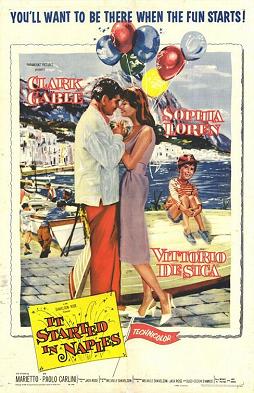
It Started in Naples is a 1960 American romantic comedy film directed by Melville Shavelson and produced by Jack Rose from a screenplay by Suso Cecchi d'Amico, based on the story by Michael Pertwee and Jack Davies. The Technicolor cinematography was directed by Robert Surtees. The film stars Clark Gable, Sophia Loren, Vittorio De Sica and an Italian cast. This was Gable's final film to be released within his lifetime and his last film in color.

Paolo Sorrentino is an Italian film director, screenwriter, and writer. He is considered one of the most prominent filmmakers of Italian cinema working today. He is known for visually striking and complex dramas and has often been compared to Federico Fellini and Michelangelo Antonioni. He has received numerous accolades including an Academy Award, BAFTA Award two Cannes Film Festival prizes, four Venice Film Festival Awards and four European Film Awards. In Italy he was honoured with eight David di Donatello and six Nastro d'Argento.

The Galli–Bibiena family, or Galli da Bibiena, was a family of Italian artists of the 17th and 18th centuries, including:

Fabrizio Santafede or Fabrizio Santaféde was an Italian painter known for his altarpieces. He painted in a style that rejected the Mannerism popular in the Naples of his time and evident in the works of Francesco Curia.
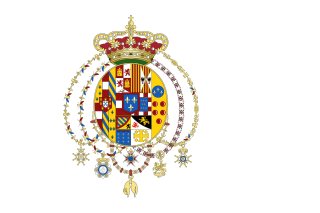
The Kingdom of the Two Sicilies was a kingdom in Southern Italy from 1816 to 1861 under the control of a cadet branch of the Spanish Bourbons. The kingdom was the largest sovereign state by population and size in Italy before Italian unification, comprising Sicily and most of the area of today's Mezzogiorno in covering all of the Italian Peninsula south of the Papal States.
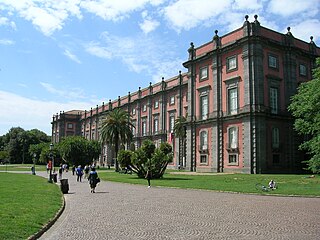
The Royal Palace of Capodimonte is a large palazzo in Naples, Italy. It was formerly the summer residence and hunting lodge of the Bourbon kings of the Two Sicilies, one of the two royal palaces in Naples. Today, it comprises the National Museum of Capodimonte and the Royal Forest. The palace was constructed on its somewhat cooler hilltop location just outside the city, with urban Naples ultimately expanding around it.
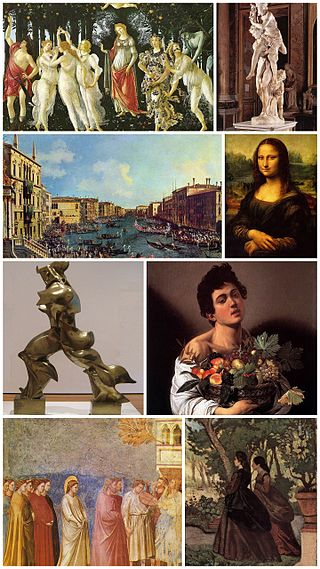
The Seicento is Italian history and culture during the 17th century. The Seicento saw the end of the Renaissance movement in Italy and the beginning of the Counter-Reformation and the Baroque era. The word seicento means "six hundred" and is short for milleseicento, 1600.

Francesco Saverio Salfi or Franco Salfi was an Italian writer, politician and librettist.
Where's Picone? is a 1983 Italian comedy film directed by Nanni Loy. Although selected as the Italian entry for the Best Foreign Language Film at the 57th Academy Awards, it was not nominated.
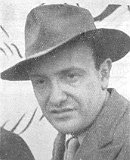
Mario Alicata was an Italian Partisan, literary critic and politician.

The Caffè Gambrinus is a historic, private cafe or coffeehouse in Central Naples, Italy on via Chiaia. It is located in the rear of the Palazzo della Prefettura, which lies in front and to side of the Royal Palace of Naples, both of which face the Piazza del Plebiscito. The name Gambrinus is a legendary somewhat tipsy figure of joviality, and his name is used for various brands and many establishments.
Don Carlo II di Tocco Cantelmo Stuart, or Carlo di Tocco for short, was an 18th/19th-century Italian noble, serving as the Prince of Montemiletto and the titular Prince of Achaea, among other titles, from the death of his father Restaino di Tocco Cantelmo Stuart in 1796 to his own death in 1823. In addition to holding various fiefs throughout Italy, Carlo also rose to prominent positions within the Kingdom of Naples and its successor state, the Kingdom of the Two Sicilies. In 1808, he came one of the earliest knights of the Royal Order of the Two-Sicilies and from 1821 to 1823, he served as a Councellor of State in the Kingdom of the Two Sicilies.